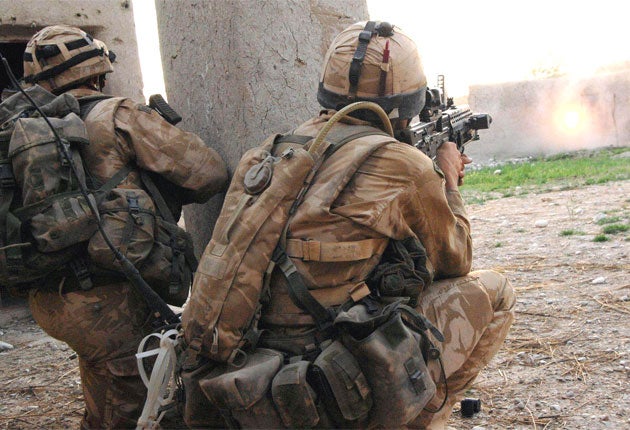British Afghan mission to come under US control

Your support helps us to tell the story
From reproductive rights to climate change to Big Tech, The Independent is on the ground when the story is developing. Whether it's investigating the financials of Elon Musk's pro-Trump PAC or producing our latest documentary, 'The A Word', which shines a light on the American women fighting for reproductive rights, we know how important it is to parse out the facts from the messaging.
At such a critical moment in US history, we need reporters on the ground. Your donation allows us to keep sending journalists to speak to both sides of the story.
The Independent is trusted by Americans across the entire political spectrum. And unlike many other quality news outlets, we choose not to lock Americans out of our reporting and analysis with paywalls. We believe quality journalism should be available to everyone, paid for by those who can afford it.
Your support makes all the difference.British troops in Helmand province will move under American control as part of a radical restructuring plan being drawn up in preparation for what is being described as a defining time in the war against the Taliban.
The Independent has learnt that command in southern Afghanistan will be split in half, with the UK troops answering to a US general.
The transfer will include key towns like Sangin, which has seen the highest number of British deaths in the conflict, mostly due to lethal roadside bombs, and Kajaki, where UK forces installed a turbine engine in an operation in 2008.
The new strategy is expected to be publicly announced by Nato later this week after prolonged negotiations between the US, Britain and the other main contributors to Isaf (International Security Assistance Force) in Afghanistan.
It comes as the traditional Afghan fighting season gets under way with General Stanley McChrystal, the US commander of Nato forces in the country, warning that "nobody was winning" a conflict that has reached a "stalemate", although the Taliban has "lost momentum".
Yesterday saw another suicide bombing in the Afghan capital with 18 people, including five American soldiers, killed. More than a thousand members of the US forces have died so far in the Afghan war.
According to senior American sources, the switch will officially take place on 1 June, when the UK's Task Force Helmand will start reporting to Maj-Gen Richard Mills of the US Marine Corps, who will command the newly formed Regional Command South-West. Until now, the UK troops answered to the British Maj-Gen Nick Carter who was in charge of the whole of southern Afghanistan. He will head another newly created command, Regional Command South, comprising the provinces of Kandahar, Oruzgan and Zabul.
General Carter's immediate focus, in the next few months, would be the forthcoming operation in Kandahar, the birthplace of the Taliban, and its hinterland. The move is expected to lead to criticism that "blood and treasure" (meaning lives and finance) expended by the British in Helmand is being given away to American control.
Critics of the plan have drawn analogies with Basra, from which British forces pulled out, ending involvement in the Iraq conflict, forcing the US Marines to take over. But UK military commanders and diplomats hold that the situation in Afghanistan is very different and that the new chain of command reflects the reality on the ground, with more than twice as many American troops than British already in Helmand.
The course of action in the near future, the "final drive" against the insurgents, will be helped, they say, by the command being split, as it will allow the generals to concentrate on their respective areas.
There is also the possibility that in the future that Maj-Gen Mills will be replaced by a British officer, although no plans have been drawn up for that, as yet. A spokesman for the Ministry of Defence told The Independent last night "We have always said that given the significant and welcome increase of ISAF forces in Helmand and across southern Afghanistan, from 35,000 in October 2009 to over 50,000 by this summer, it is absolutely right that ISAF commanders should be considering changes to command and control structures.
"To do so makes complete military sense and will ensure that ISAF and Afghan forces are put to best use in the interest of the wider mission. The UK has been fully involved in the decision-making process," he said.
The new command structure will mean that British troops will concentrate on guarding population centres, while US forces, who took the lead in the recent Marjah offensive, will take over some of the outlying bases.
British troops, who have lost almost half of their members killed this year in Sangin, will remain in that town, under overall US command, and may see the arrival of some reinforcements. At Kajaki, where a hydroelectric project was supposed to provide power for a huge swathe of southern Afghanistan, the UK forces are expected to be replaced by Americans.
Join our commenting forum
Join thought-provoking conversations, follow other Independent readers and see their replies
Comments